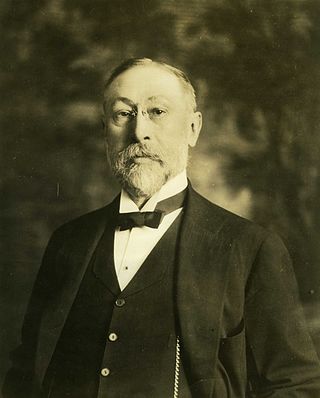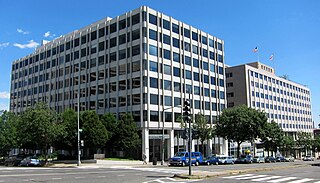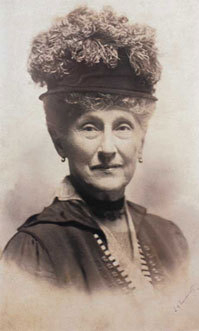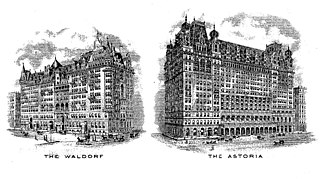
A Waldorf salad is a fruit and nut salad generally made of celery, fresh apples, walnuts, and grapes, dressed in mayonnaise, and traditionally served on a bed of lettuce as an appetizer or a light meal. The apples, celery, and grapes can all be green, which harmonizes the color palette of the dish.

Oscar Tschirky was a Swiss-American restaurateur who was maître d'hôtel of Delmonico's Restaurant and subsequently the Waldorf-Astoria Hotel in Manhattan, New York, United States. He was widely known as "Oscar of the Waldorf" and published a large cookbook.

The Waldorf Astoria New York is a luxury hotel and condominium residence in Midtown Manhattan in New York City. The structure, at 301 Park Avenue between 49th and 50th Streets, is a 47-story 625 ft (191 m) Art Deco landmark designed by architects Schultze and Weaver and completed in 1931. The building was the world's tallest hotel until 1957, when it was surpassed by Moscow's Hotel Ukraina. An icon of glamor and luxury, the Waldorf Astoria is one of the world's most prestigious and best-known hotels. Once owned by Conrad Hilton, Waldorf Astoria Hotels & Resorts, a division of Hilton Hotels, operates under the name of the original hotel in locations around the world. Both the exterior and the interior of the New York's Waldorf Astoria are designated by the New York City Landmarks Preservation Commission as official landmarks.

Harold Lloyd "Harry" Hopkins was an American statesman, public administrator, and presidential advisor. A trusted deputy to President Franklin Delano Roosevelt, Hopkins directed New Deal relief programs before serving as the eighth United States secretary of commerce from 1938 to 1940 and as Roosevelt's chief foreign policy advisor and liaison to Allied leaders during World War II. During his career, Hopkins supervised the New York Temporary Emergency Relief Administration, the Federal Emergency Relief Administration, the Civil Works Administration, and the Works Progress Administration, which he built into the largest employer in the United States. He later oversaw the $50 billion Lend-Lease program of military aid to the Allies and, as Roosevelt's personal envoy, played a pivotal role in shaping the alliance between the United States and the United Kingdom.

George Charles Boldt Sr. was a Prussian-born American hotelier. A self-made millionaire, he influenced the development of the urban hotel as a civic social center and luxury destination.

A charitable organization or charity is an organization whose primary objectives are philanthropy and social well-being.
The Charity Organisation Societies were founded in England in 1869 following the 'Goschen Minute' that sought to severely restrict outdoor relief distributed by the Poor Law Guardians. In the early 1870s, a handful of local societies were formed with the intention of restricting the distribution of outdoor relief to the elderly.

The New England Society in the City of New York (NES) is one of several lineage organizations in the United States and one of the oldest charitable societies in the country. It was founded in 1805 to promote “friendship, charity and mutual assistance” among and on behalf of New Englanders living in New York.

The United Charities Building, also known as United Charities Building Complex, is at 105 East 22nd Street or 287 Park Avenue South, in the Gramercy Park neighborhood of Manhattan, New York City, near the border of the Flatiron District. It was built in 1893 by John Stewart Kennedy, a wealthy banker, for the Charity Organization Society. It was designated a National Historic Landmark in 1991 for the role the Charity Organization Society played in promoting progressive social welfare policies, including the development of academic disciplines in that area.

In 1899 James Barr Ferree, an historian and native Pennsylvanian living in New York City, invited 55 fellow Pennsylvanians also living in New York to join him for dinner at The Waldorf Astoria Hotel. While enjoying a meal together, they decided to form a group known initially as “The Pennsylvania Society of New York.” Their goal was to establish a society “uniting all Pennsylvanians at home and away from home in bonds of friendship and devotion to their native or adopted state” and would meet for dinner every year, same time, same place.
The Saint Andrew's Society of the State of New York is the oldest charitable institution in the state of New York and is focused on helping Scots in the New York community with the motto Charity, Fellowship, Scholarship.

The Waldorf-Astoria Orchestra was an orchestra that played primarily at the Waldorf Astoria Hotel, both the old and new locations. In addition to providing dinner music at the famous hotel, the orchestra made over 300 recordings and many radio broadcasts. It was established in the 1890s, and was directed by Carlo Curti in early 1900s, Joseph Knecht at least from 1908 to 1925, later by Jack Denny and others, and then Xavier Cugat from approximately 1933 to 1949.
Family and Children's Services of Central Maryland, Inc. doing business as Springboard Community Services (SCS), formerly Family and Children's Services (FCS), is a private, nonsectarian social services agency that was founded in 1849. SCS addresses issues from birth through the end of life with a goal to build self-confidence, resilience and hope. SCS is a 501(c)(3) non-profit organization.

Elizabeth Milbank Anderson, American philanthropist and advocate for public health and women's education, was the daughter of Jeremiah Milbank (1818–1884), a successful commission merchant, manufacturer and investor, and Elizabeth Lake (1827–1891). Anderson established in 1905 one of the first foundations funded by a woman, the Memorial Fund Association, with gifts of $9.3 million by the time of her death. Anderson in her lifetime supported a wide range of health and social reform efforts during the Progressive Era, from tuberculosis and diphtheria eradication to relief work for European children following World War I, for which she was made in 1919 a Chevalier of the Legion of Honor by the French government.
The Chicago Relief and Aid Society was one of several charitable organizations created in Chicago in the latter part of the 19th century to provide aid and support to people and families living in poverty. Founders of the organization modeled it after the Association for Improving the Condition of the Poor in New York.

The Waldorf-Astoria originated as two hotels, built side by side by feuding relatives, on Fifth Avenue in New York, New York, United States. Built in 1893 and expanded in 1897, the hotels were razed in 1929 to make way for construction of the Empire State Building. Their successor, the current Waldorf Astoria New York, was built on Park Avenue in 1931.
Robert Milham Hartley (1796–1881) was one of the co-founders of the temperance movement in New York and during his life sought to improve the conditions and health of the poor.
Ruth Vanderbilt Twombly was an American philanthropist, tennis coach, socialite, and heiress to the Vanderbilt family fortune.

325 East 38th Street is a seven-story commercial building located between First and Second avenues in the Murray Hill neighborhood of Manhattan in New York City. The building originally opened in 1904 as public baths and was subsequently renovated and expanded, later housing other entities including a wet wash laundry, medical centers, and a nursing school. It currently serves as the permanent mission for Indonesia to the United Nations.














